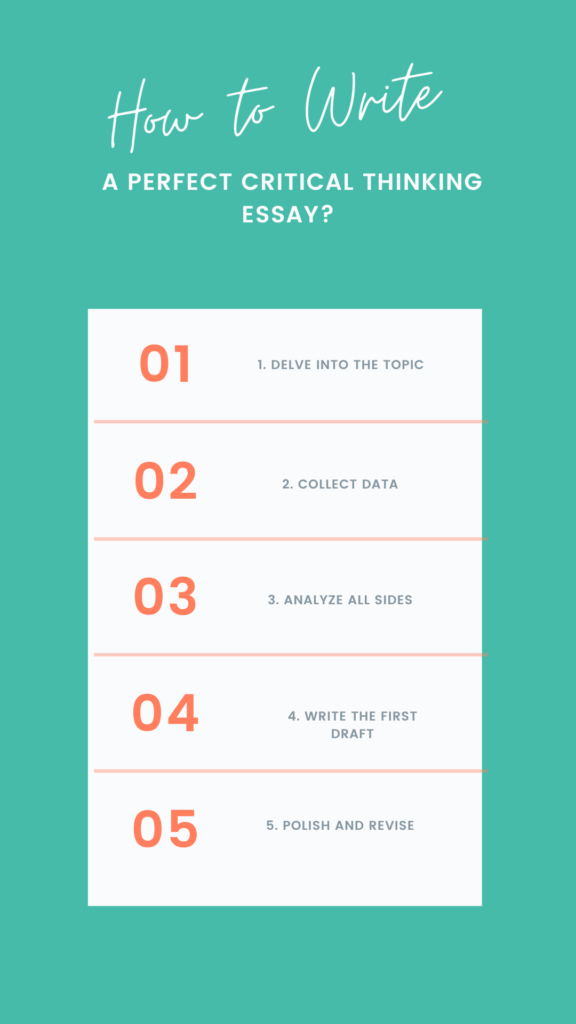Have you ever found yourself in a scenario when thinking critically gave you a competitive edge? Or when your reasoning spared you the trouble of taking the longer path toward a specific goal? Using logic instead of emotions to make conclusions is vital for everybody’s educational and career goals.
Sharpening your critical thinking involves extensive research and writing evidence-based and well-developed academic papers. And while this task can be challenging, evaluating data and providing justified opinions can become less complicated with practice. Edusson can provide assistance in this process, offering helpful tips and resources to help you improve your critical thinking skills. And while this task can be challenging, evaluating data and providing justified opinions can become less complicated with practice.
This article offers an overview of the definition, outline, and formatting rules with tips on writing a critical-thinking essay. It also features an example of what you should include in your paper for the best possible outcome.
What Is a Critical Thinking Essay?
As a writing type, critical thinking essays aim to demonstrate your ability to consider information critically and present reliable findings. With it, teachers strive to help students improve their analytical skills and work with loads of information.
One of the most practical ways to arm learners with this ability is through written assignments. This way, they learn that the essence of critical analysis essay writing is to ponder and answer the right questions. Moreover, these essay types are beneficial for solving problems, reflecting on events, and analyzing experiences.
The methods leading to an excellent written piece include reading texts carefully, taking a methodological approach, and finding weaknesses and discrepancies. Moreover, the student must elaborate on various concepts, rationalize and structure data, and express thoughts clearly.
The challenge behind these academic tasks is to succeed in both creating a high-quality essay and developing well-founded arguments about an issue. Teachers will assess your knowledge of a specific topic and the skills to filter out questionable data. To this end, ensure you have a robust standpoint based on credible research.
Additionally, when you feel overwhelmed by the challenge of these academic tasks, you can rely on the expertise of professionals who offer buy research papers to provide you with quality essays and well-founded arguments.
How to Write a Critical Thinking Essay Outline?
Outlining your paper serves as an organizer that eases your further work. The structure resembles critical response essays in terms of length and layout. However, there are some aspects you need to be aware of to write a perfect, critically oriented essay.
Introductory Segment
The opening part presents the general idea of your essay. Its purpose is to introduce the readers to the issue by grabbing their attention at the onset. You can also include well-known facts and highlight the importance of the problem. Finally, ensure you end the introduction with your thesis statement that announces the consecutive explanations.
Main Part
The body can consist of several paragraphs, depending on how many assertions you want to discuss. Typically, it makes up about 90% of the entire essay. If you struggle with the layout, consider a professional custom writing service for advice and guidance on framing your paper.
Use the body to develop the outline underpinning the main issue. To this end, you will need to rely on trustworthy research, citations, and examples. Unbiased fact collection will also help you take a convincing viewpoint backed up by relevant evidence and persuade readers to adopt your attitude.
Writers can also include counter-arguments to showcase their aptitude for tackling different opinions and rejecting them as irrelevant. Counter-arguments can also give credibility and objectivity to your piece. Most importantly, ensure you dedicate one paragraph per idea.
Another unique feature of critical papers is the chance to portray your opinion in an additional body section. You can explain whether and how it transformed during the research phase.
Closing Segment
The final part should evaluate cross-references, summarize arguments, and urge further research. Also, the essay must end with a logical summary of the findings by referring back to the earlier points. Use this section to stress what you were trying to prove.
The skeleton of the ideal critical thinking essay should look like this:
Introduction
- Hook and background information
- General facts and terms
- Thesis statement
Body
- Source evaluation
- Argument and counter-argument development
- Credible evidence and examples
Conclusion
- Summary of all considerations
- Mention existing areas of doubt
- Call for action.
How to Write a Perfect Critical Thinking Essay?
Presenting various standpoints and defending yours with plausible supporting ideas can be time-consuming. To help you out, we offer guidelines for conceptualizing a high-rated critical thinking essay format. Follow the five steps below.

1. Delve into the Topic
Study the requirements provided by your mentor and apply them in detail. Your teacher might also pick a topic for you (book, movie, art, historical event, or a social dilemma) or leave this to your discretion. Ensure you understand the instructions before you start researching and gathering information. It is also advisable to read materials that address the subject matter.
2. Collect Data
Gather relevant notes about the issue that will help you write your paper. Besides primary sources of information, you might also consult critics’ reviews and online materials. Ideally, you should collect at least five references, such as books, journals, and articles. All these must be closely related to your topic and support your argumentation.
3. Analyze All Sides
Assess the evidence you find and touch upon all aspects of the issue. Don’t forget to establish your position and formulate a compelling thesis statement. Any argument you decide to include in your final work must be well-substantiated. Finally, use this step to show your creative self and present new perspectives on the dilemma that nobody has explored before.
4. Write the First Draft
Many wonder how to start a critical thinking essay and attract the readers’ interest. To this end, use engaging statistics and facts, share an anecdote, or pose a thought-provoking question. Steer away from cliché and overgeneralized beginnings.
When writing the essay, ensure all reasoning supports the main claim and contributes to your position. Be consistent and concise, and don’t go off tangent by adding irrelevant information or fillers. Add explanations if you deem this will help the reader better grasp the topic.
The body paragraphs should also judge the value of your discussion. Those who struggle with structure might turn to a descriptive essay writing service to provide samples or edit their rough draft. Conducting deep process analysis and selecting credible and controversial ideas requires honed critical thinking skills.
5. Polish and Revise
When the first draft is ready, sleep on it and proofread it the following day. Check whether the paper offers reliable argumentation and consistent and accurate facts. You must also ensure your work is free of typos and grammatical mistakes. Moreover, transitioning from one idea to another is vital to convey your thoughts. If you’re struggling to meet these requirements, consider taking advantage of a college paper writing service to help polish your paper. Finally, scan your work for possible plagiarism and check whether you cited your references properly (parenthesis or footnotes).
What Are the Critical Thinking Essay Formatting Tips?
The essay formatting is essential for the final assessment. Hence, many people buy a literature essay online to ensure an excellent grade. Supposing you use the MLA format, pay attention to the following rules:
- The title page must include a top heading, your and your instructor’s full name, the course, and the due date.
- The paper should be double-spaced with 1-inch margins.
- Include a page header with page numbers on the right side.
- Write in 11 or 12 font sizes.
- Set 1/2” indent for new paragraphs.
- When citing, include the author’s name and page number at the end of the sentence in parentheses.
- Add a “Works Cited” section on a separate page at the end.
Critical Thinking Essay’s Paragraph Example
Learning through examples is practical and straightforward. Therefore, we included a sample to highlight the importance of a critical thinking essay.
Is Taking a Gap Year Worth the Effort?
Do you fear taking a year off school to grow as a person and find your life passion? When it comes to the decisive point of applying for college, it’s essential to consider taking a gap year to assess the situation. This way, you have enough time to gauge your skills and capabilities, explore job opportunities, or take a break from studying.
According to a national alumni survey, most participants claimed they developed mentally and emotionally and boosted their self-confidence…
Another research by…
Finally, …
To conclude, a gap year can offer invaluable opportunities to carve your future self…



